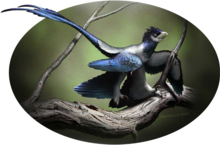
Back ديناصور ذو ريش Arabic Dinosaure amb plomes Catalan Opeření dinosauři Czech Gefiederte Dinosaurier German Plumhavaj dinosaŭroj Esperanto Dinosaurios con plumas Spanish دایناسور پردار Persian Liskolintu Finnish Dinosaure à plumes French Dinosauros emplumados Galician


A feathered dinosaur is any species of dinosaur possessing feathers. That includes all species of birds, and in recent decades evidence has accumulated that many non-avian dinosaur species also possessed feathers in some shape or form. The extent to which feathers or feather-like structures were present in dinosaurs as a whole is a subject of ongoing debate and research.
It has been suggested that feathers had originally functioned as thermal insulation, as it remains their function in the down feathers of infant birds and bytoday prior to their eventual modification in birds into structures that support flight.
Since scientific research began on dinosaurs in the early 1800s, they were generally believed to be closely related to modern reptiles such as lizards. The word dinosaur itself, coined in 1842 by paleontologist Richard Owen, comes from the Greek for 'terrible lizard'. That view began to shift during the so-called dinosaur renaissance in scientific research in the late 1960s; by the mid-1990s, significant evidence had emerged that dinosaurs were much more closely related to birds, which descended directly from the theropod group of dinosaurs.[1]
Knowledge of the origin of feathers developed as new fossils were discovered throughout the 2000s and the 2010s, and technology enabled scientists to study fossils more closely. Among non-avian dinosaurs, feathers or feather-like integument have been discovered in dozens of genera via direct and indirect fossil evidence.[2] Although the vast majority of feather discoveries have been in coelurosaurian theropods, feather-like integument has also been discovered in at least three ornithischians, suggesting that feathers may have been present on the last common ancestor of the Ornithoscelida, a dinosaur group including both theropods and ornithischians.[3] It is possible that feathers first developed in even earlier archosaurs, in light of the discovery of vaned feathers in pterosaurs.[4][5] Fossil feathers from the dinosaur Sinosauropteryx contain traces of beta-proteins (formerly called beta-keratins), confirming that early feathers had a composition similar to that of feathers in modern birds.[6] Crocodilians also possess beta keratin similar to those of birds, which suggests that they evolved from common ancestral genes.[7][8]
- ^ Brown, Joseph W.; Van Tuinen, M. (2011). "Evolving Perceptions on the Antiquity of the Modern Avian Tree". Living Dinosaurs. pp. 306–324. doi:10.1002/9781119990475.ch12. ISBN 9781119990475.
- ^ Farago, Jason (7 March 2019). "T. Rex Like You Haven't Seen Him: With Feathers". The New York Times. Retrieved 7 March 2019.
- ^ Baron, Matthew G.; Norman, David B.; Barrett, Paul M. (23 March 2017). "A new hypothesis of dinosaur relationships and early dinosaur evolution". Nature. 543 (7646): 501–506. Bibcode:2017Natur.543..501B. doi:10.1038/nature21700. PMID 28332513. S2CID 205254710.
- ^ Michael Benton, A colourful view of the origin of dinosaur feathers. Nature 604, 630-631 (2022)
- ^ Cincotta, A., Nicolaï, M., Campos, H.B.N. et al. Pterosaur melanosomes support signalling functions for early feathers. Nature 604, 684–688 (2022). https://doi.org/10.1038/s41586-022-04622-3
- ^ Slater, Tiffany S.; Edwards, Nicholas P.; Webb, Samuel M.; Zhang, Fucheng; McNamara, Maria E. (21 September 2023). "Preservation of corneous β-proteins in Mesozoic feathers". Nature Ecology & Evolution. 7 (10): 1706–1713. doi:10.1038/s41559-023-02177-8. ISSN 2397-334X. S2CID 262125827.
- ^ Greenwold, Matthew J.; Sawyer, Roger H. (September 2013). "Molecular evolution and expression of archosaurian β-keratins: Diversification and expansion of archosaurian β-keratins and the origin of feather β-keratins". Journal of Experimental Zoology Part B: Molecular and Developmental Evolution. 320 (6): 393–405. doi:10.1002/jez.b.22514. PMID 23744807.
- ^ Alibardi, L.; Knapp, L. W.; Sawyer, R. H. (1 June 2006). "Beta-keratin localization in developing alligator scales and feathers in relation to the development and evolution of feathers". Journal of Submicroscopic Cytology and Pathology. 38 (2–3): 175–192. ISSN 1122-9497. PMID 17784647.
© MMXXIII Rich X Search. We shall prevail. All rights reserved. Rich X Search